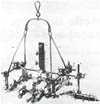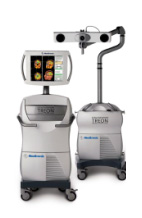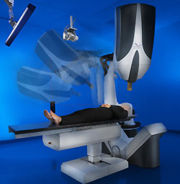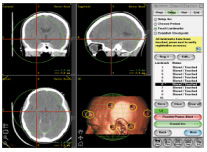Stereotactic
Image Guidance in Brain Surgery
Introduction
In general, a surgery can be called image-guided if some indirect visualization is used for operation, for example, if fiber optics, endoscopy, ultrasonography or other imaging technique is involved.
A surgery is called stereotactic if a system of three-dimensional (3D)
coordinates is used to locate the operative field, and to navigate surgical instruments around it.
Stereotactic image guidance combines both above-mentioned features by means of real-time registration of the operative field to a preoperative imaging data
set, showing the precise location of surgical instruments relative to surrounding anatomical structures.
Stereotactic
image guidance is often used in neurosurgery for operating on the brain. In frameless stereotactic system, the skull itself represents a rigid 3D frame of
reference, relative to which brain structures of interest are located
by registration to computed tomography (CT), magnetic resonance imaging
(MRI), and other 3D image data sets.
Stereotactical devices for brain surgery have gone a long way from the
first Horseley-Clarke apparatus designed in 1906 for animal
experiments, and based on brain atlas, to modern state-of-the-art
systems, of which three examples are considered on these web pages.




StealthStation®
technology is developed by Medtronic, Inc. StealthStation is
equipped with specialized software that combines pre-operative images
from various sources (CT, MRI) into an integrated 3D image set, and has
a capability to update those data by intra-operative imaging.
Real-time registration is performed with a 360-degree optical tracking
and laser-pointing system.
Gamma Knife®
is a stereotactic radiosurgery technology that was originally developed
by Swedish neurosurgeon Lars Leksell in 1967, and is currently
commercialized by Elekta company. Gamma Knife technology combines
images from stereotactic CT, MRI, positron emission
tomography (PET), magnetoencephalography (MEG), and/or cerebral
angiography, and uses them for target determination and radiation beam
focusing.
CyberKnife®
stereotactic radiosurgery system was developped at Stanford around
1994, and was approved by FDA in 2001 for radiational treatment of
tumors in various parts of the body. The CyberKnife system uses a
combination of robotics and image-guidance technologies.















